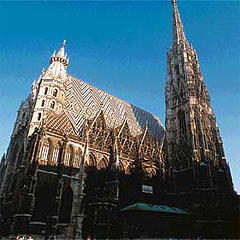


Vienna is the capital and largest city in Austria. It is the 9th largest city by population in the European Union. The city is host to many international organizations, including OPEC and one of the four official seats of the United Nations Organization.
2012 it was announced to be one of the most livable cities in the world by the EIU Global Liveability Report. The center of Vienna was designated a UNESCO World Heritage Site.
Various architectural styles can be discovered. Imposing structures range from magnificent classicist buildings to modern architecture. Friedensreich Hundertwasser himself designed many of the well-known buildings which should be planned in each city trip. The Ringstrasse is well-known for its late-19th- century grand buildings, monuments and parks. The Romanesque Ruprechtskirche, Baroque Karlskirche, Gothic Stephansdom, Highbaroque Jesuitenkriche, Rococo Schönbrunn Palace, Baroque Belvedere Palace are only a few of the impressive buildings in Vienna which a tourist should not miss.
Vienna is known for its classical music. Mozart, Beethoven, Haydn and Schubert recognized the glory of this city to use it as a muse for composing their brilliant masterpieces. The wonderful sounds of these and other prominent composers are still accessible in the operas, concert halls and other facilities, which are famous for its pomp and circumstance.
Traditional coffeehouses are ready to be explored at every turn in the city. Since 2011 the “Viennese Coffee House Culture” belongs to the intangible cultural heritage of UNSECO. Male waiters in tailcoats will serve the wide variety of coffee drinks on silver patters on marble tabletops and the whole historical atmosphere would be topped off with piano music.
A huge variety of different museums can be visited. The Kunsthistorische Museum and Naturhistorische Museum are located close to Museumsquartier. The Museumsquartier houses a number of museums such as the Museum of Modern Art and Leopold Museum which contains the largest collection of paintings by Egon Schiele. As the former imperial mews of Empress Elisabeth of Austria, the Museumsquartier is now used as a public space which features cafés, galleries and squares for music and other performances.
The climate in Vienna is generally mild and continental. Often a moderate westerly wind makes cool days even cooler. But the Viennese appreciate this wind because it brings fresh air from the surrounding Vienna Woods to the city.
The nights in August are comfortably warm with an average low temperature of 14°C. In the afternoons, the mercury climbs to an average high of 24°C, but depending on the prevailing conditions, temperatures over 30°C are not uncommon.
The total amount of rainfall is 58 mm this month, making it the fourth-wettest month of the year, after the three previous months. There are 13 days with some kind of rainfall, a number that returns in the majority of the months. Of the three main types of precipitation that occur in August, moderate rain is by far the most common one. It is observed on no less than 53% of the days with rainfall. Thunderstorms occur on 29% of those days, while light rain happens on 16% of them.
Emergency rooms are open round the clock at the following hospitals:
Allgemeines Krankenhaus
phone: +43 1 404 00
Hanusch-Krankenhaus
phone: +43 1 910 21-0
Lorenz Böhler Unfallkrankenhaus
phone: +43 1 331 10
Unfallkrankenhaus Meidling
+43 1 601 50-0
Doctor on call: Radio-telephone service (round the clock); phone 141
Ambulance: phone 144
If you need a dentist after hours call +43 1 512 20 78 (recorded message in German only). If you need a pharmacy outside opening hours, phone 1550 (in German only).